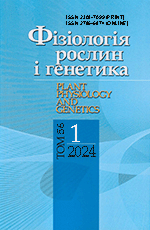Визначено найліпший спосіб стерилізації насіння розторопші плямистої, для якого характерна максимальна кількість життєздатного і стерильного насіння (98—99 %). Виявлено залежність індексу росту від комбінації фітогормонів у культуральному середовищі. Для отримання калюсної тканини розторопші плямистої червоноквіткового сорту Золушка білоруської селекції і білоквіткового сортозразка Sibilla угорської селекції незалежно від походження експлантатів оптимальним є середовище на основі середовища Мурасиге—Скуга, що містить 1 мг/л 2,4-дихлорфеноксіоцтової кислоти і 0,4 мг/л кінетину.
Ключові слова: Silybum marianum L., розторопша, культура in vitro, стерилізація, калюсогенез, фітогормони, індекс росту
Повний текст та додаткові матеріали
У вільному доступі: PDFЦитована література
1. Verpoorte, R., Contin, A. & Memelink, J. (2002). Biotechnology for the production of plant secondary metabolites. Phytochem. Rev., 1, No. 1, pp. 13-25. https://doi.org/10.1023/A:1015871916833
4. Hahn, G., Lehmann, H.D., Kurten, M., Uebel, H. & Vogel, G. (1968). On the pharmacology and toxicology of silymarin, an antihepatotoxic active principle from Silybum marianum (L.) Gaertn. Arzneimittel-Forschung, 18, No. 6, ss. 698-704.
5. Kurkin, V.A. (2003). Milk thistle — a source of medicines (review). Chemist-pharmacist. Journal, Pt. 37, No. 4, pp. 27-41.
6. Kurkin, V.A. & Zapesochnaya, G.G. (1987). Flavolignans and other natural lignoids. Problems of structural analysis. Chemistry of Natural compounds, No. 1, pp. 11-34. https://doi.org/10.1007/BF00602450
7. Wellington, K. & Adis, B.J. (2001). Silymarin: а review of its clinical properties in the management of hepatic disorders. BioDrugs, 15, No. 7, pp. 465-489. https://doi.org/10.2165/00063030-200115070-00005
8. Fructus silybi mariae [Electronic resource] (2004). 2. Mode of access: http:// apps.who.int/medicinedocs/en/d/Js4927e/. Date of access: 16.10.2017.
9. Luper, S. (1998). A review of plants used in the treatment of liver diseases. Pt. 1 Alternative Med. Rev., 3, No. 6, pp. 410-421.
10. Wichtl, M. (2004). Herbal Drugs and Phytopharmaceuticals: a handbook for practice on a scientific basis. Stuttgart; Boca Raton: CRC Press.
11. Dr. Duke's phytochemical and ethnobotanical databases [Electronic resource] (2017). US Dep. of Agr., Nat. Agr. Libr. Mode of access: https://phytochem.nal. usda.gov/phytochem/search. Date of access: 13.10.2017.
12. Pedersen, M. (1987). Nutritional herbology: including the nutritional profiles of 106 commonly used herbs and foods. [S. l.]: Pedersen Pub.
13. Valenzuela, A., Guerra, R. & Videla, L.A. (1986). Antioxidant properties of the flavonoids silybin and (+)-cyanidanol-3: comparison with butylated hydroxyanisole and butylated hydroxytoluene. Planta Med., 52, iss. 6, pp. 438-440. https://doi.org/10.1055/s-2007-969247
14. Krecman, V., Skottova, N., Walterova, D., Ulrichova, J. & Simanek, V. (1998). Silymarin inhibits the development of diet-induced hypercholesterolemia in rats. Planta Med., 64, iss. 2, pp. 138-142. https://doi.org/10.1055/s-2006-957391
15. Chubarova, A.S., Kapustin, M.A., Spiridovich, E.V. & Kurchenko, V.P. (2012). The content of flavolignans in the fruits of thistle Silybum marianum (L.) of various chemoraces. Vestn. pharmacy, No. 4, pp. 28-31.
16. Verpoorte, R., Choi, Y.H. & Kim, H.K. (2007). NMR-based metabolomics at work in phytochemistry. Phytochem. Rev., 6, No. 1, pp. 3-14. https://doi.org/10.1007/s11101-006-9031-3
17. Kopach, O.V., Kuzovkova, A.A. & Reshetnikov, V.N. (2013). Physiological and biochemical features of Silybum marianum L. of red and white flowering races when introduced into in vitro culture and callusogenesis. Cell biology and plant biotechnology: theses. Intern. scientific-practical. Conf., Minsk, February 13-15, 2013 / The Byelorussian. state. un-t [and others; Ed. advice: V. V. Demidchik and others]. Minsk.
18. Sanchez-Sampedro, M.A., Pelaez, R. & Corchete, P. (2018). An arabinogalactan protein isolated from medium of cell suspension cultures of Silybum marianum (L.) Gaernt. Carbohydrate Polymers, 71, No. 4, pp. 634-639.
19. Firouzi, A., Mohammadi, S.A., Khosrowchahli, M., Movafeghi, A. & Hasanloo, T. (2013). Enhancement of silymarin production in cell culture of Silybum marianum (L.) Gaertn by elicitation and precursor feeding. J. of Herbs, Spices and Med. Plants, 19, No. 3, pp. 262-274. https://doi.org/10.1080/10496475.2013.791908
20. Kuzovkina, I.N., Chernysheva, T.P. & Alterman, I.E. (1979). Characteristics of the strain of callus tissue of Ruta Graveolens producing rutacridone. Plant physiology, 26, No. 3, pp. 492-499.
